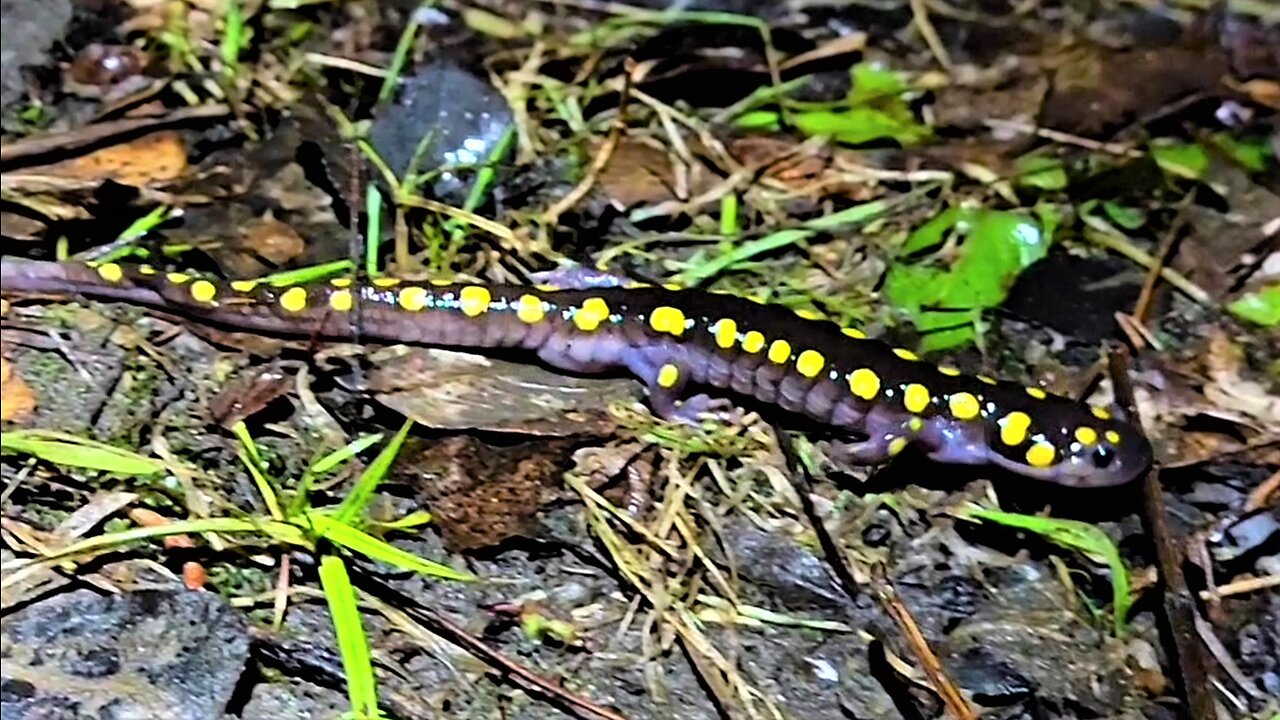Premium Only Content

Yellow spotted salamander makes dangerous trek once each year
The spotted salamander is abundant in the forests of North America, yet they are rarely seen. They hide underground, or deep under leaf litter, feeding on worms and insects at night, usually without venturing into the open. They emerge during breeding season in March to May each year, when the ice has barely melted on the nearby vernal ponds.
The salamanders leave their cover to make their way en masse to the water where they breed. On a rainy night, as if every salamander for miles is answering the same call, on the same schedule, they begin a trek over open ground. It is a trip that renders them vulnerable to predators. But nature calls and the salamanders such as this one will answer that call.
The eggs are laid in the vernal pools where they develop and hatch into tadpoles. The eggs of the spotted salamander hold a symbiotic relationship with an algae that grows within them. This provides energy and oxygen as the eggs mature. This is necessary because some of the eggs have a membrane that will not allow for oxygen to pass through from the surrounding water.
Salamanders can live for up to 32 years in the wild. They must remain sheltered from the sunlight during that entire time.
Their skin must remain moist for them to survive.
-
 2:05:10
2:05:10
Kim Iversen
15 hours agoFree Speech for Me, But Not for Thee: Trump Admin’s Protester Crackdown Sounds MAJOR Alarms
94.9K481 -
 1:29:26
1:29:26
Glenn Greenwald
15 hours agoICE Detains Permanent Resident for Protesting Israel; European Leaders Make Maniacal Rearmament Vows They Cannot Keep | SYSTEM UPDATE #421
168K294 -
 1:02:56
1:02:56
Donald Trump Jr.
17 hours agoUSAID Slush Fund Slashed, X Cyberattack, Plus Interview with Nate Morris | Triggered Ep.223
156K187 -
 5:48:40
5:48:40
Dr Disrespect
21 hours ago🔴LIVE - DR DISRESPECT - THE SHOTTY BOYS - WARZONE, PUBG, FORTNITE
268K43 -
 2:12:50
2:12:50
Adam Carolla
22 hours agoDouble Murder Convict to be executed by Firing Squad + Comedian Elon Gold + Comedian Carol Leifer
110K22 -
 46:08
46:08
Kimberly Guilfoyle
18 hours agoBad Day to be a Bad Guy: FBI Taking Down World’s Worst Criminals, Live with John Nantz | Ep.203
221K86 -
 DVR
DVR
Redacted News
17 hours agoWhat's REALLY going on in Syria? | Redacted with Natali Morris
216K146 -
 54:18
54:18
Candace Show Podcast
17 hours agoHarvey Speaks: Jessica Mann & The Five Year Affair | Ep 3
238K126 -
 56:53
56:53
Grant Stinchfield
16 hours ago $11.08 earnedFreeze Spending & Kick the Can Down the Road... Why Republicans Should do Just That!
130K27 -
 56:48
56:48
VSiNLive
16 hours agoFollow the Money with Mitch Moss & Pauly Howard | Hour 1
98.1K1